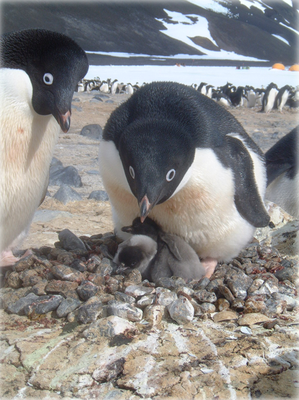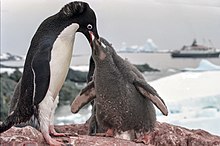Adelie penguin
| Adelie penguin | ||||||||||||
|---|---|---|---|---|---|---|---|---|---|---|---|---|

Adelie penguins at the nest |
||||||||||||
| Systematics | ||||||||||||
|
||||||||||||
| Scientific name | ||||||||||||
| Pygoscelis adeliae | ||||||||||||
| ( Hombron & Jacquinot , 1841) |
The Adelie penguin ( Pygoscelis adeliae ) is an Antarctic- sub- Antarctic species of penguins belonging to the long-tailed penguin genus . The black head, the white ring around the eye and the relatively small-looking beak are characteristic of the Adelie penguin. Besides the emperor penguin , it is the only penguin species found on the main part of the Antarctic continent. A breeding colony of this kind in the Ross Sea is even considered to be the southernmost penguin colony in the world. The species is named after the wife of the French polar explorer Jules Dumont d'Urville .
No subspecies are distinguished for this species. The IUCN currently classifies the Adelie penguin as harmless ( least concern ).
Appearance
The Adelie penguin reaches a body length of 70 centimeters and is one of the medium-sized penguins. There is no noticeable sexual dimorphism , but females are slightly smaller than males. Females weigh between 3.9 and 4.7 kilograms, males weigh between 4.3 and 5.3 kilograms. The plumage shows no seasonal variation, young birds can be distinguished from adult birds up to an age of one year. Adult Adelie penguins have a blue-black head and a blue-black upper body. Shortly before moulting, however, the worn plumage appears brownish. A noticeable white skin ring runs around the eye. In addition, the underside of the body is white, the chin and throat are black and sharply contrasted with the white breast. The wings, which have been transformed into fins, are black on the upper side and white on the underside with a dark spot at the end of the fin. The beak is predominantly black, only at the base of the beak it brightens to an orange-red. It looks very short because over half of it is covered by feathers. The iris is brown. The legs and feet are matt white to pink, the soles are black. The Adelie penguins moult shortly after the young birds have fledged.
Fledglings have a white throat and black eye ring up to about 14 months of age.
Adelie penguins, with their dark face and lack of elongated head feathers, cannot be confused with any other species of penguin. Young birds are similar to chinstrap penguins , but Adelie penguins have no white above the eyes and no black plumage below the chin.
voice
The contact call of the Adelie penguin is a short bark, which is onomatopoeically described as aark . This call, which lasts about 0.3 seconds, can also be heard by Adelie penguins on the open sea. The threatening sounds include a kind of growl, which is often accompanied by glances at another penguin. It can be heard especially when another penguin enters the immediate breeding area. Before Adelie penguins chop at other penguins, they utter a similar short sound that sounds a little harsher than the threatening sound. Grunting grr or gwarr -Laute are heard when they fight with another bird.
The vocalizations of the Adelie penguins, which they hear during the advertisement for the partner bird, are very varied. A rhythmic call that lasts three to seven seconds is part of the courtship behavior of the Adelie penguin. It is only occasionally expressed by the females, but very frequently by the males. Courtship behavior also includes loud, harsh and trumpeting sounds, which are often called by both birds in the vicinity of the nest. A gentle, humming sound can be heard when partner birds court each other directly at the nest location. Newly hatched chicks make a weak beep.
Distribution area
Adelie penguins are circumpolar. Their range is limited by the ice shelf border in the south and the pack ice border in the north. They are rarely found in open waters and prefer regions with thick pack ice. Their breeding area extends from Cape Royds , the western branch of Ross Island along the coast of Antarctica to the west coast of the Antarctic Peninsula , along islands of the Scotia Sea to the South Sandwich Islands . The range of non-breeding birds is not very well understood. Presumably they do not migrate further than the edge of the pack ice border. Stray visitors are occasionally seen on the South American, Australian and New Zealand coasts. They also appear on subarctic islands in the Indian and Pacific Oceans.
The largest breeding colony is on Cape Adare . About 282,307 breeding pairs breed there.
Food and subsistence
Adelie penguins mainly live on small crustaceans and also eat small fish. They usually find their prey at depths between ten and forty meters, but are able to dive up to 170 meters. Around forty percent of diving time is spent in water below 12.5 meters. In the breeding colonies further north, they only look for food during the daytime during the breeding season. In the more southern breeding colonies they search for food all day.
The length of time that Adelie penguins search for food varies greatly depending on the location of the breeding colony and the availability of food there. At Cape Bird, the northernmost branch of Ross Island, Adelie penguins take off for nine to 25 days during the breeding season to forage. Distances of up to 100 kilometers from the breeding colony could be detected. While the young birds are rearing, the Adelie penguins stay closer to the breeding colony. A little more than half of the breeding birds do not move more than 10 kilometers from the colony. Breeding birds on Béchervaise Island moved up to 341 kilometers away during the breeding season, but not more than twelve kilometers when rearing their young. Adelie penguins returning to the breeding colony travel between 2.2 and 3.4 kilometers per hour as long as the egg is still incubated. Adelie penguins that are already raising a young bird can reach speeds between 3.2 and 4.6 kilometers per hour.
Reproduction
As is often the case with species that are very widespread in the south of the Antarctic, the breeding season of the Adelie penguins is very short. The breeding season begins as soon as the coastal waters reach a temperature above freezing point. The coastal waters are often still covered with ice at the beginning of the breeding season and Adelie penguins often have to overcome ice barriers in order to be able to reach their breeding colonies.
Adelie penguins live and breed in colonies, which can often be of considerable size. Breeding colonies are found on rocky islands, peninsulas and coastal areas that are ice-free. The southernmost colonies are often located in places that are exposed to both sun and wind and therefore remain free of snowdrifts. Further north, Adelie penguins prefer more protected locations for their breeding colonies.
On Ross Island there is a colony of Adelie penguins with about half a million individuals. They are very local. In the Antarctic summer they live on the mainland, otherwise on the edge of the open pack ice zone. Their population is estimated at around 20 million animals.
The breeding season for these penguins begins in October. The females lay their eggs in the nests made of heaped stones and then go looking for food again. The males alone do the breeding. Until the cubs hatch after 35 days, they will not eat anything. When the young have hatched, the females return to help raise them. At the age of two to three weeks, the young birds form groups of children or so-called kindergartens. This enables both parent birds to look for food. Young birds are particularly sensitive to climatic influences. The mortality rate among young birds increases particularly significantly when the snow melts, so that the down feathers of the nestlings get wet.
Males without a partner form groups, at least in part, and show aggressive sexual behavior towards young animals or kill and injured females.
Duration
The population was estimated at 7.58 million breeding birds in 2014. The stock is considered stable to slightly increasing. All breeding colonies in the Ross Sea , for example, increased between 3 and 30 percent between 1981 and 1988. The increases may be related to increased food supply from the warming of the southern oceans. In the Antarctic Peninsula, where this warming is less pronounced, the increases are less pronounced. Stocks here increased slightly after the egg collection was stopped there.
In 2017, a previously unknown population of around 1.5 million Adelie penguins was discovered on the Danger Islands .
In general, Adelie penguins are very sensitive to human interference. In those places where research stations such as Cape Royds were built, the stocks declined. They only recovered after stricter rules limited human disturbance there.
supporting documents
literature
- Klemens Pütz and Christine Reinke-Kunze: Animal World of the Antarctic and Subantarctic , Antarctic Research Trust, Forch 2009, ISBN 978-3-033-01791-7
- Hadoram Shirihai: A Complete Guide to Antarctic Wildlife - The Birds and Marine Mammals of the Antarctic Continent and Southern Ocean , Alula Press, Degerby 2002, ISBN 951-98947-0-5
- Tony D. Williams: The Penguins . Oxford University Press, Oxford 1995, ISBN 0-19-854667-X
- Dr. George Murray Levick: Penguins: a study of their social habits . McBride Nast & Company, 1914
Web links
- Pygoscelis adeliae in the Red List of Threatened Species of the IUCN 2008. Posted by: BirdLife International, 2008. Accessed on December 18 of 2008.
- Videos, photos and sound recordings of Pygoscelis adeliae in the Internet Bird Collection
- spiegel.de June 10, 2012: Research results on the sexual behavior of Adelie penguins emerge almost 100 years after their creation (by researcher George Murray Levick )
Single receipts
- ↑ Pütz and Reinke-Kunze, p. 26
- ↑ a b BirdLife factsheet on the Adelie penguin , accessed on March 2, 2018
- ^ Williams, p. 171
- ^ Williams, p. 169
- ↑ Shirihai, p. 63
- ^ Williams, p. 170
- ↑ a b c d e Williams, p. 172
- ^ Williams, p. 172 and p. 173
- ↑ a b c d Williams, p. 173
- ↑ Sirihai, p. 64 and p. 65
- ↑ Shirihai, p. 65
- ↑ Douglas GD Russella, William JL Sladena and David G. Ainley: "Dr. George Murray Levick (1876-1956): unpublished notes on the sexual habits of the Adélie penguin", Polar Record, pages 1-7, Cambridge University Press, 2012 (web link)
- ↑ Antarctica: One and a half million penguins that no one knew about before. In: Deutschlandfunk . March 2, 2018, accessed March 2, 2018 .
- ↑ A. Borowicz, P. McDowall, C. Youngflesh et al .: Multi-modal survey of Adélie penguin mega-colonies reveals the Danger Islands as a seabird hotspot . In: Nature . doi : 10.1038 / s41598-018-22313-w .






